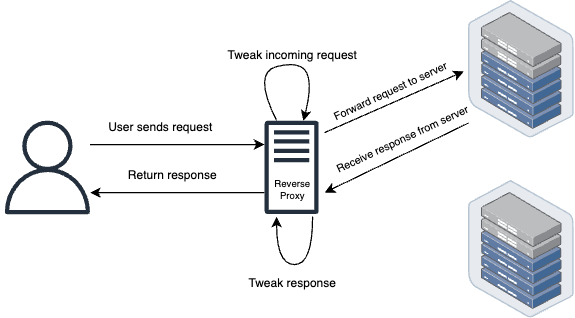Beginner's Guide to Reverse Proxies: Mastering the Digital Middleman


Have you ever wondered how websites ensure secure connections, balance the load among multiple servers, or control which users can access specific content? Enter the world of reverse proxies—a foundational concept for anyone diving into web development or IT.
In this guide, we'll unpack the essentials of what a reverse proxy is, how it operates, and why it's crucial in today's digital landscape.
What is a Reverse Proxy?
At its core, a reverse proxy is a server that stands between client devices (like your computer or smartphone) and web servers. When you request a webpage or online service, the reverse proxy decides where to send that request. Once the web server sends back the data, the reverse proxy then sends it to you.
Think of a reverse proxy as a middleman between users and a server. Here's how it works step-by-step:

User Requests: Someone tries to visit your website and sends a request. Instead of going directly to your server, this request first goes to the reverse proxy.
Tweaking Incoming Request: Before doing anything, the reverse proxy might make some changes to this request. For example, it could remove parts that aren't needed or add some extra information that might help the server.
Deciding Where to Send: The reverse proxy checks where to send this request. If you have more than one server, it picks the best one for the job.
Fetching the Data: The chosen server processes the request and sends the response (like a webpage) back to the reverse proxy.
Tweaking Outgoing Response: Just as it can tweak incoming requests, the reverse proxy can also adjust the server's response before sending it to the user. This could mean compressing images to make them load faster or adding security headers to keep the data safe.
Delivering to the User: Finally, after all these steps, the reverse proxy sends the data to the person who asked for it.
Remember, the main goal of the reverse proxy is to make sure everything runs smoothly. It helps manage traffic to avoid server overloads, ensures users get the correct data, and can even improve performance and security along the way.
How Does It Differ from a Forward Proxy?
Imagine you’re at a massive library, where books represent the websites or online resources you want to access.
Forward Proxy
You want to borrow a specific book, but you don't want the librarians (websites) to know who's borrowing it. So, you ask a friend (the forward proxy) to get the book for you. The librarians only see your friend and have no idea you're the actual reader. This way, your identity and book choices remain private
Reverse Proxy
Now imagine the librarians use helpers (reverse proxies) to manage and distribute books. When you need a book, instead of going directly to the vast storage area to search, you talk to the helper. The helper decides which shelf or section (server) has the book you want and fetches it for you. The helper can also remember which books are popular and keep them at hand (caching) or recommend similar books you might like (load balancing). In this way, the main storage area (main server) doesn't get overwhelmed by every single request from all library visitors.
Why Use a Reverse Proxy?
Load Balancing: If a website becomes popular, it might be served by multiple servers to handle the traffic. A reverse proxy can distribute incoming requests to different servers, ensuring no single server is overwhelmed.
Security and Anonymity: By hiding the identity of backend servers, reverse proxies protect them from direct exposure to malicious attacks.
SSL Termination: Handling SSL (the protocol for secure web traffic) requires computational resources. A reverse proxy can manage this process, offloading the work from backend servers.
Caching: Reverse proxies can store copies of responses from servers. So, when clients request the same content, the proxy can provide it directly, reducing the load on servers.
Compression: To speed up data transfers, reverse proxies can compress outbound data from servers.
Final Thoughts
While setting up a basic reverse proxy is straightforward, mastering its intricacies requires practice and understanding. As you delve deeper into web infrastructure, you'll discover the powerful versatility of reverse proxies in optimizing, securing, and enhancing online services.

